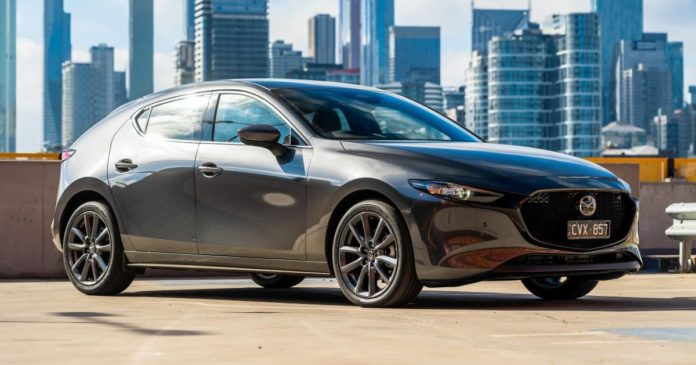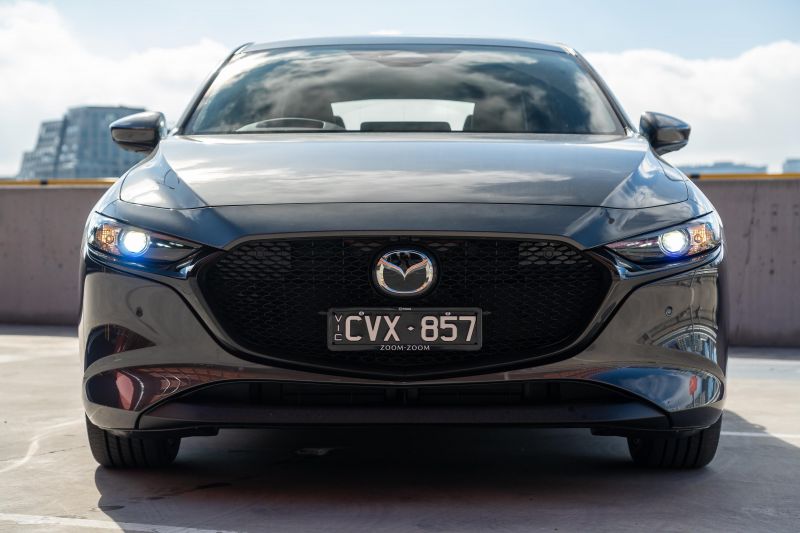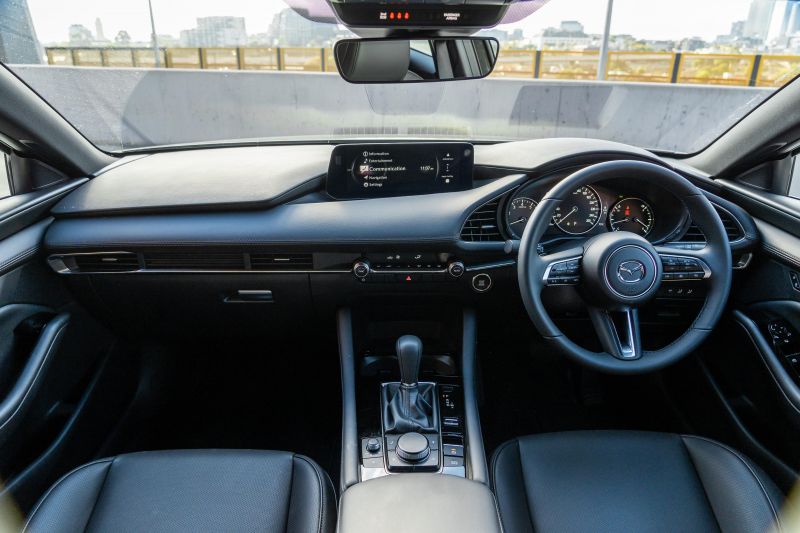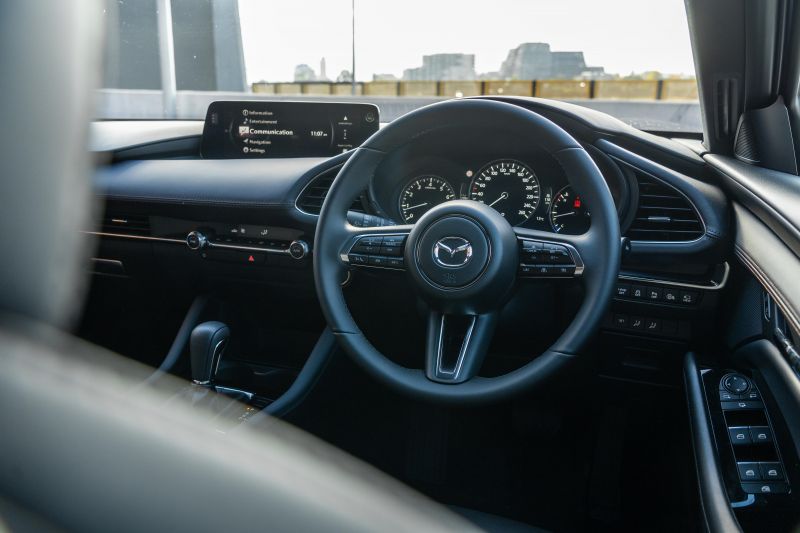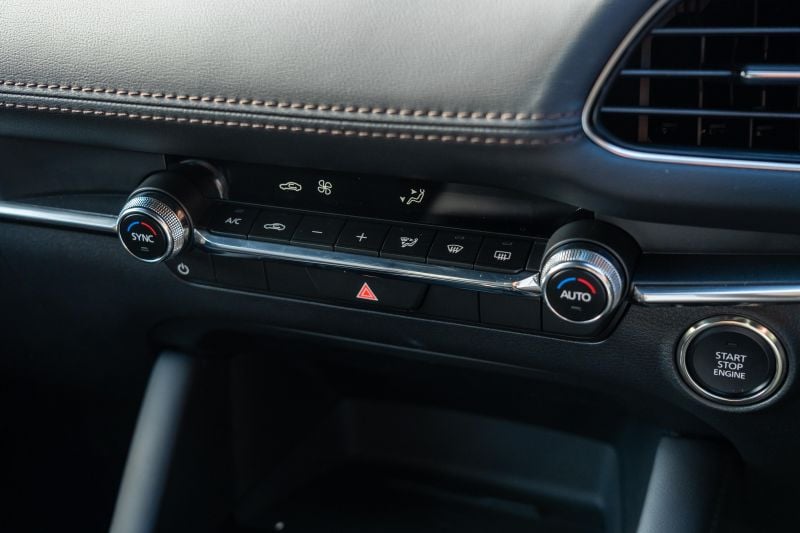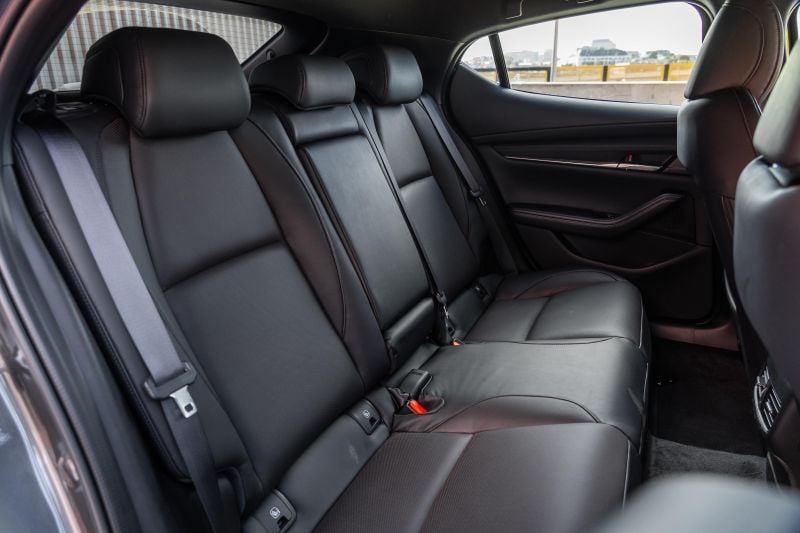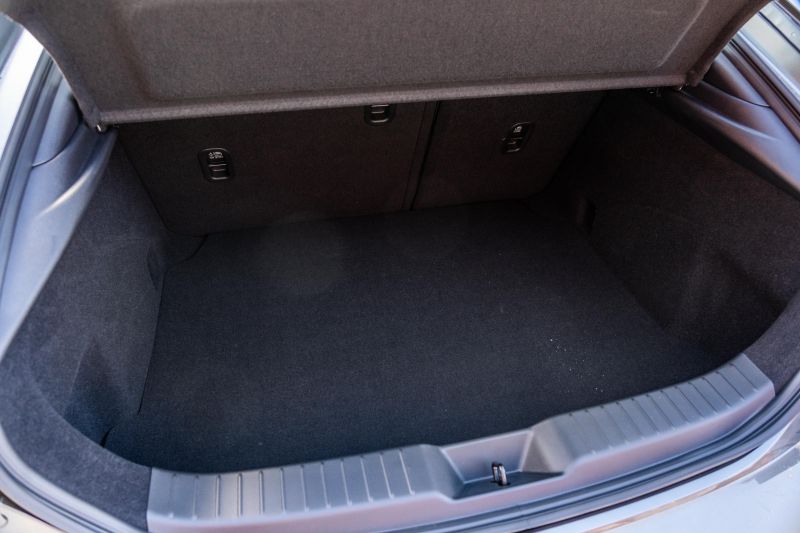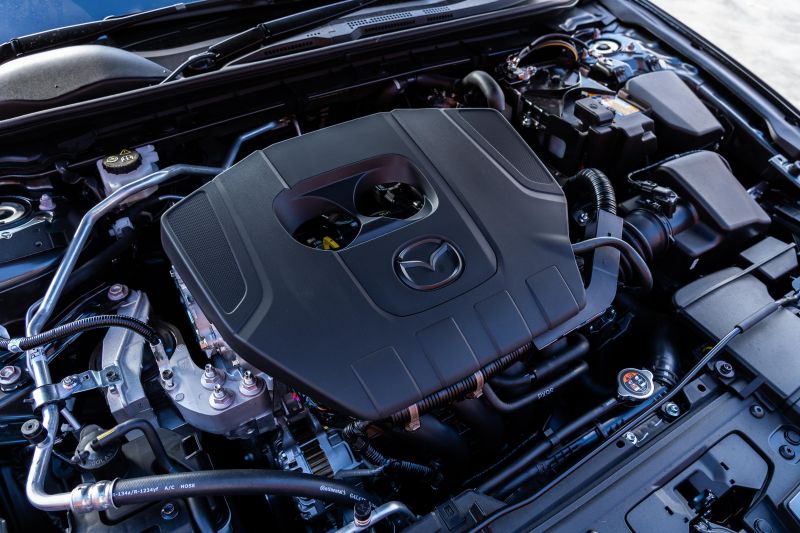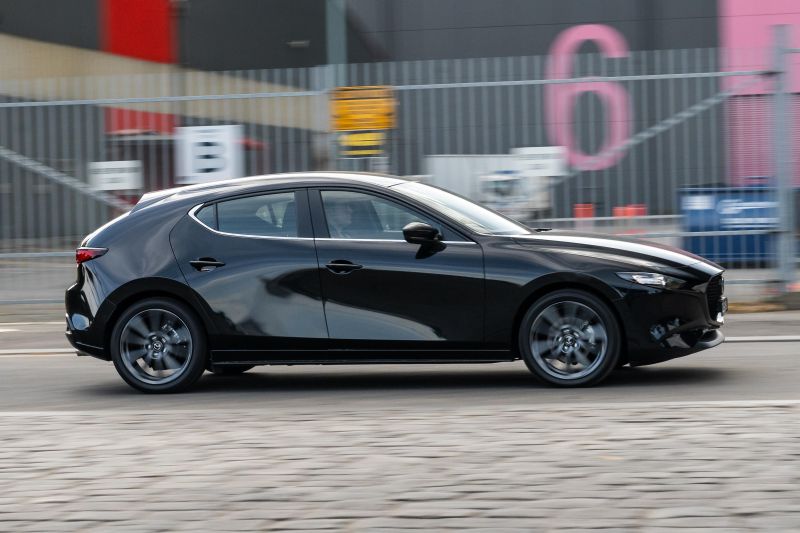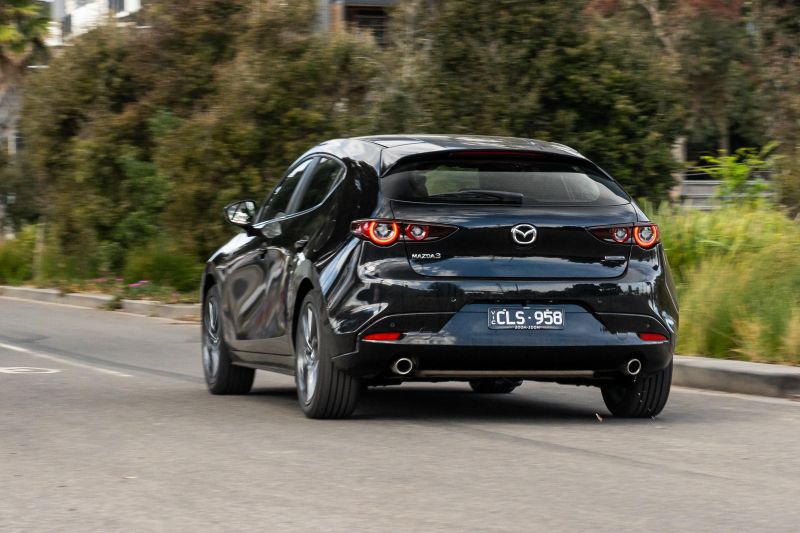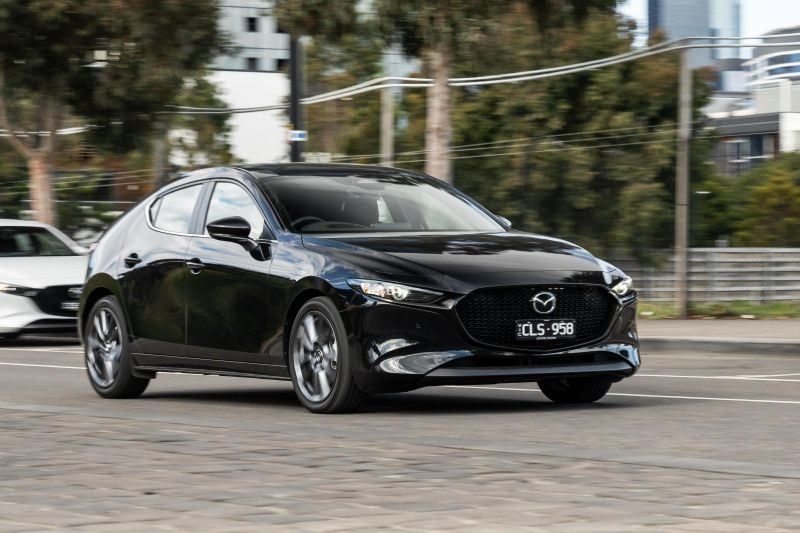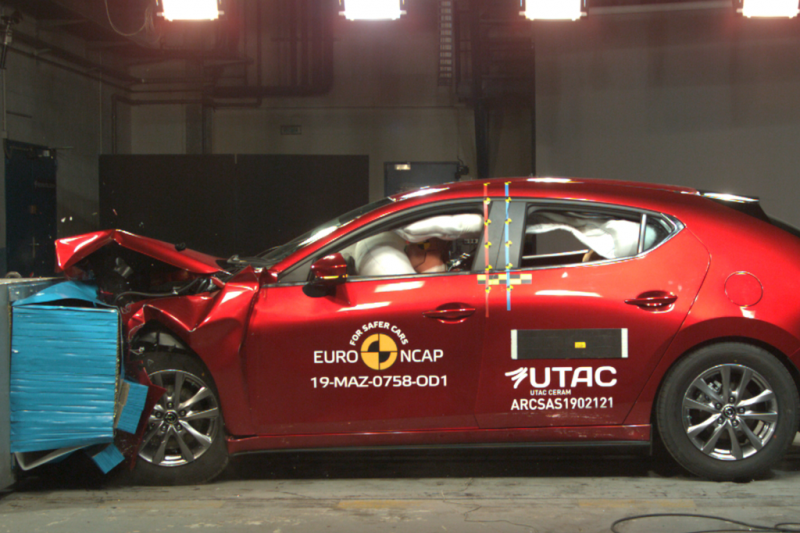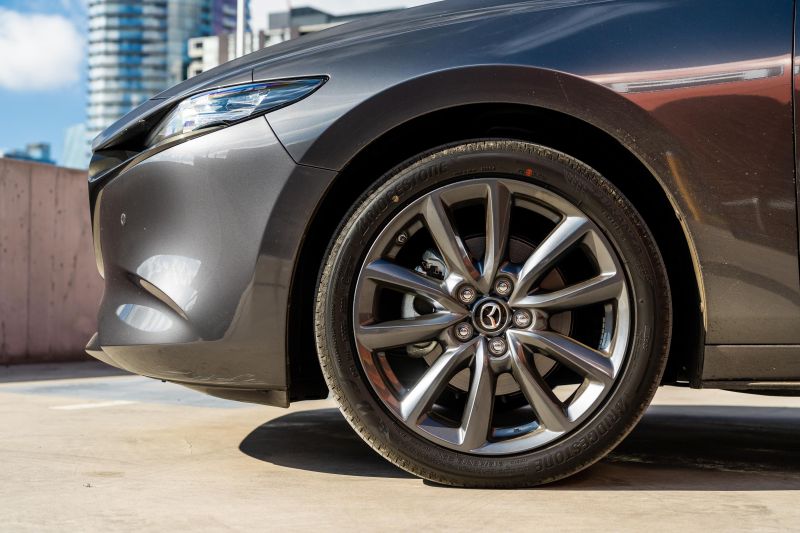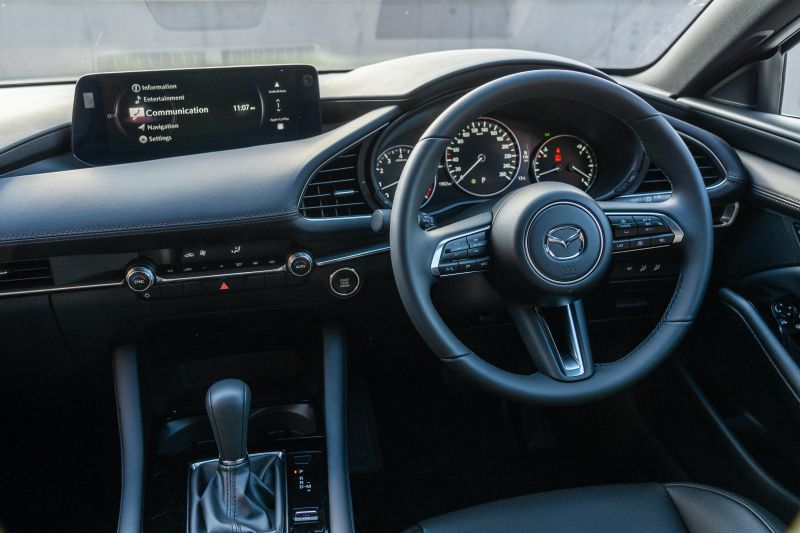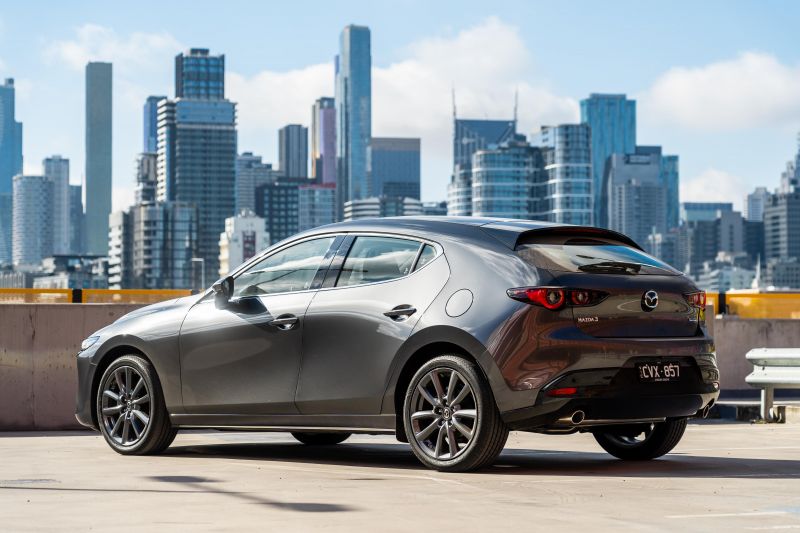The Mazda 3 has a tried and tested recipe at its core, but there’s been a shift from the original formula in recent years.
What was once a practical, spacious, exceedingly popular small hatch is now somewhat less so, as interior dimensions have shrunk and it’s no longer an Australian top-seller.
It is definitely more than capable of holding its own, though. Yes, rivals like the better-selling Hyundai i30 and Toyota Corolla are cramming in more storage space for a similar cost, but it doesn’t change the fact that Mazda is still at the top of a segment that has shrunk in the past 10 years.
The current Mazda 3 launched in 2019, and more than 9000 examples were delivered last year. It’s received several running changes since then, though it’s not had any major cosmetic updates.
It’s still an attractive small car. It’s got an aggressive yet sleek face and the rear is characterised by slender, organic tail lights, while the grey 18-inch alloys and black accents are an added bonus.
The round hatch body is well-proportioned despite it limiting visibility out the rear. Its interior has a distinctly premium feel, and it handles surprisingly well for a car in its class.
Here on test is the 2024 Mazda 3 G20 Touring Hatch, the most expensive variant of the 2.0-litre range. With the Vision Technology Package included, it also packs the full suit of Mazda’s safety and assist features.
This 2024 G20 comes with a larger infotainment display, wireless smartphone mirroring, and fuel-saving cylinder deactivation, though it did lose the manual and mild-hybrid availability from previous models.
With that in mind, is it still a good pick in the limited, highly-competitive small car segment?
How does the Mazda 3 compare?
View a detailed breakdown of the Mazda 3 against similarly sized vehicles.

Mazda
Mazda 3
How much does the Mazda 3 cost?
The 2024 Mazda 3 G20 Touring hatch is priced from $34,670 plus on-road costs. Mazda offers both hatch and sedan bodies at no extra cost.
| Model Variant | $RRP |
|---|---|
| Mazda 3 G20 Pure | $30,470 |
| Mazda 3 G20 Evolve | $32,020 |
| Mazda 3 G20 Touring | $34,670 |
| Mazda 3 G25 Evolve SP | $34,670 |
| Mazda 3 G25 GT | $38,570 |
| Mazda 3 G25 Astina | $42,470 |
Prices are before on-road costs
The Vision Technology Package is a $2000 option on the G20 Touring, and adds:
- Surround-view camera
- Cruising & Traffic Support
- Driver monitoring
- Front cross-traffic alert
- Front parking sensors
- 10.25-inch Mazda Connect infotainment screen
To see how the Mazda 3 compares against its rivals, line it up using our comparison tool.
What is the Mazda 3 like on the inside?
You’d be forgiven for thinking the Mazda 3 was more expensive than it is – especially for less than $40,000, its interior is a surprisingly classy and comfortable place to be.
It’s very well put together with excellent material quality. Everything, from the steering wheel and dash top to the seats and door cards, is nice to the touch, with much of the cabin plastered in soft-touch materials in places even higher-end manufacturers gloss over.
As the driver you get a very ‘cocooned’ feel thanks to the supportive seats, low roofline, high dash, black headliner, and overall small dimensions. That’s not by any means a negative mark on the Mazda 3, but instead part of the reason it feels as premium as it does.
It’s got a powered driver’s seat and manual steering wheel adjustment with a wide range of mobility, which makes it very easy to hop in and get yourself sorted.
Areas like the sides of the centre console are also padded, along with the two armrests on either side of the driver. Unfortunately, there is a fair bit of fingerprint-attracting gloss-black trim on the centre console.
You’ll notice immediately how far away the infotainment system is on its perch atop the dashboard, but it’s easily navigable using the rotary dial, buttons, and volume/power knob on the centre console.
It offers clean graphics and a crisp display on its 10.25-inch screen, which is upgraded from the standard 8.8-inch display with the Vision Technology Package.
Touchscreen functionality has also now been added and is definitely a benefit, as smartphone mirroring with Apple CarPlay and Android Auto can be clumsy to navigate using the dial exclusively.
Apple CarPlay can be connected wirelessly in the Touring spec and I found it to be responsive and easy to use – most of the time.
On two occasions towards the end of our week with the Mazda 3, my iPhone 12 refused to connect to the car wirelessly after working normally just a few minutes prior. A mutual ‘forget this device’ on both ends soon fixed the problem, but it was still an inconvenience.
Underneath the infotainment system is where you’ll find climate controls, which are a series of buttons and knobs that are easy to use and much more intuitive than other fully-touchscreen interfaces.
Other buttons are kept to a minimum on the centre console, which is also where you’ll find the sturdy gear selector and a storage box with two USB-C outlets inside. There are also cupholders nearby, but you won’t fit any big bottles in here.
The steering wheel is where you’ll find most of the driver assist controls, and behind it is an instrument cluster comprised of a screen flanked by two analogue gauges. I’m a fan of this mixed display; it’s easily legible, stylish, and something that isn’t always seen on modern cars.
It shows only vehicle speed and vehicle monitoring info by default, but you can cycle through the available instrument displays to a digital speedometer gauge if you’d prefer that look, too.
Getting in the back seats of the Mazda 3 is straightforward thanks to its doors that open to nearly 90 degrees. Once you’re there, you’ll notice how much more closed-in and dark it feels as a result of the thick C-pillars and sloping roofline.
That doesn’t mean it’s a tiny space, though, as I (an average-height adult, unlike my weird colleagues) had no problems with head- or legroom. I’ll caveat that by saying taller people will likely run into some issues, depending on where the front seats are positioned.
There’s also not a lot of toe room under the front seats and the floor is split by a raised tunnel, but rear passengers do get air vents and a fold-down centre armrest in all Mazda 3s except the base G20 Pure.
Three top-tether and two ISOFIX anchor points for child seats are included, along with a map pocket on the passenger side and small bottle holders in the doors.
While it’s small for passengers in the rear, the Mazda 3 is even smaller for cargo in the boot.
That’s perhaps its weakest point, as it only has 295L of quoted boot space with the rear seats up and a tight, high entry. Mazda also doesn’t quote a seats-down capacity, but you do get a space saver spare wheel across the range.
For comparison, that’s less than hatch rivals like the Kia Cerato (428L), Hyundai i30 (395L) at a similar price point.
| Dimensions | Mazda 3 Hatch |
|---|---|
| Length | 4460mm |
| Width | 2028mm |
| Height | 1435mm |
| Wheelbase | 2725mm |
| Boot capacity (VDA) | 295L – 2nd row up |
What’s under the bonnet?
G20 models are powered by a 2.0-litre naturally aspirated petrol engine.
| Model | Mazda 3 G20 Touring |
|---|---|
| Engine | 2.0L 4cyl |
| Power | 114kW @ 6000rpm |
| Torque | 200Nm @ 4000rpm |
| Transmission | 6-speed automatic |
| Driven wheels | Front-wheel drive |
| Weight | 1414kg – kerb |
| 0-100km/h | 9.0 seconds |
| Fuel economy – claimed | 5.9L /100km |
| Fuel economy – as tested | 7.4L /100km |
| Fuel tank size | 51L |
| Fuel requirement | 91 RON |
That fuel economy figure should be taken with a grain of salt, as most highway stints in the car were plagued by the gridlock of Melbourne’s rush-hour traffic.
As the name implies, G25 models feature a larger 2.5-litre four-cylinder engine with 139kW of power and 252Nm of torque. Still no turbo, though.
To see how the Mazda 3 compares against its rivals, line it up using our comparison tool.
How does the Mazda 3 drive?
While it’s classy offering inside and out, the Mazda 3 still behaves as you’d expect for a cheaper small car once you hit the road.
-

G20 Evolve Hatch shown
It’s – unsurprisingly – better aligned with a sports car than anything else, but even so, a couple of key characteristics serve as reminders we’re dealing with a (relatively) affordable city hatch with a lovely cabin, rather than a bigger, thoroughly luxurious land barge.
On certain sections of coarse freeway, for example, there was a lot of tyre noise making its way into the cabin.
Realistically, a bit of noise isn’t the end of the world, but when you’re presented with such a classy interior and an aura of a much more premium car, you’d definitely expect it to be a touch quieter.
On a cold start the engine is also very noisy, producing a diesel-like racket that soon quietens down once it warms up or you start moving.
The 2.0-litre powertrain lacks some punch, but it’s at least enough to get you up to speed from traffic lights, on a freeway on-ramp, or when overtaking a slower vehicle.
Flicking it into Sport mode helps in the above scenarios too, as it holds gears longer and forces the car to rev higher to access the maximum 114kW that comes relatively high in the RPM range.
In normal driving the torque converter automatic transmission behaves as it should, though there were moments when a shift wasn’t as smooth as it could be or it held a gear slightly too long. It’s not the worst, but it could serve to be ironed out.
To its benefit, the more traditional automatic gives a sense of familiarity that means there’s no learning curve for those coming from an older car – it’s just get in and go.
In any case, we’d suggest the more powerful G25 models if you’re after more performance and excitement.
On turn-in, the Mazda 3 is more than capable of handling itself. It stays flat with excellent body control and inspires more confidence than you’d expect from a car that isn’t explicitly sporty.
The steering is also nicely weighted and gives a performance-oriented feel, though it does mean it’s a touch more difficult to navigate tight car parks at low speed.
It remains comfortable on most roads, but bumpy routes in regional Victoria can become fairly brutal on longer drives.
Adaptive cruise control and lane centring work well together, and the lane keep assist function isn’t too intrusive. That means it won’t put up too much of a fuss if you need to avoid a pothole, but it’s still there to pull you back if you veer out of your lane on the highway.
The driver assists and monitoring features weren’t always perfect, however. Its ‘i-stop’ automatic stop/start function works as it should, but it often restarts the engine with a jolt as you come off the brake pedal. Thankfully, this can be easily turned off via a button to the right of the steering wheel.
I was consistently told it was time to take a break 20 minutes into my commute, and that I was being inattentive for doing head checks or checking the passenger side mirror. The AEB system also flashed a false warning at one point, loudly warning me to brake when going uphill with no cars in front.
These flaws aren’t unique to Mazda, but the quality of the rest of the car’s systems and controls does make the off moments stand out.
Regardless, the Mazda’s integration of such a wide array of features is impressive and generally effective, so it shouldn’t be discounted for some occasional missteps.
What do you get?
The Touring grade is third up the trim ladder of G20-powered Mazda 3 models.
G20 Pure highlights:
- 16-inch alloy wheels
- Automatic LED headlights
- Automatic high-beam
- Rain-sensing window wipers
- Rear spoiler (hatch only)
- Auto-folding side mirrors
- 7.0-inch digital instrument cluster
- 8.8-inch Mazda Connect infotainment system
- Wired Apple CarPlay and Android Auto
- Satellite navigation
- DAB+ digital radio
- 8-speaker sound system
- Push-button start
- Electric park brake
- Leather-wrapped steering wheel and gear selector
- Black cloth upholstery
G20 Evolve adds:
- 18-inch grey alloy wheels (hatch only)
- Dual-zone climate control
- Rear air vents
- Paddle shifters
- Auto-dimming rear-view mirror
- Rear centre fold-down armrest
G20 Touring adds:
- Auto-dimming driver’s side mirror with reverse tilt down and heating function
- Side mirror memory
- Wireless Apple CarPlay and Android Auto
- Wireless phone charger
- Two USB-C ports
- Keyless entry
- Overhead sunglasses storage
- Vanity mirror illumination
- Black leather upholstery
- 10-way power driver’s seat adjustment with lumbar and two-position memory
Vision Technology Package* adds:
- Surround-view camera
- Cruising & Traffic Support
- Driver attention monitoring
- Front parking sensors
- Front cross-traffic alert
- 10.25-inch Mazda Connect infotainment screen
*$2000 on G20 Pure, G20 Evolve, G20 Touring, and G25 Evolve SP; $1500 on G25 GT
The G25 range offers many of the same features, though the flagship G25 Astina adds a sunroof and includes the Vision Technology Package as standard.
Is the Mazda 3 safe?
The Mazda 3 has a five-star safety rating from ANCAP, based on testing conducted in 2019.
Standard safety equipment on all Mazda 3 models includes:
- Adaptive cruise control with stop/go
- Front, front-side, curtain and driver’s knee airbags
- Autonomous emergency braking – forward, reverse
- Blind-spot monitoring
- Driver attention alert
- Lane departure warning
- Lane-keep assist
- Rear cross-traffic assist
- Reversing camera
- Rear parking sensors
- Traffic sign recognition
- Tyre pressure monitoring
- Front, front-side and curtain airbags
- Driver’s knee airbag
The Vision Technology Package adds Cruising & Traffic Support, which is a Level 2 autonomous driving feature that combines adaptive cruise control and lane-centring.
Additionally, it includes driver attention monitoring, a surround-view camera, front parking sensors and front cross-traffic alert.
How much does the Mazda 3 cost to run?
The Mazda 3 range is backed by a five-year, unlimited-kilometre warranty.
12 month or 15,000km service intervals are offered with the Mazda 3, along with a seven-year capped-price scheme.
The cost of servicing a Mazda 3 averages out at around $450 a year, making it more expensive to maintain than the offerings from other brands like Toyota.
By comparison, the first five services on the Corolla Hybrid sedan are capped at $245.
2024 Mazda 3 service pricing:
| Service interval | G20 | G25 |
|---|---|---|
| 1yr or 15,000km | $346 | $352 |
| 2yr or 30,000km | $545 | $552 |
| 3yr or 45,000km | $427 | $427 |
| 4yr or 60,000km | $545 | $552 |
| 5yr or 75,000km | $346 | $352 |
| 6yr or 90,000km | $626 | $626 |
| 7yr or 105,000km | $346 | $352 |
| Total: | $3181 | $3213 |
CarExpert’s Take on the Mazda 3
There’s still a reason the Mazda 3 was the third best-selling car in its segment last year.
It looks good, drives well, and for the price it certainly doesn’t skimp on some of Mazda’s higher-end tech that comes with the optional Vision Technology Package. On the lower-trim G20 options, that makes for a considerable bargain.
Though it’s now more than five years old it still mechanically matches many of its naturally-aspirated rivals, and gives plenty of choice with the two displacements available.
That being said, it does lack any form of hybrid technology against the likes of a Corolla, and real-world fuel economy figures reflect it.
Our 7.4L/100km could easily have been slashed by crawling along with an electric motor, and a broader gear range would have made it more economical on the highway.
It’s also small. Its compact body means you can’t fit a whole lot in the boot, and the rear seats leave a bit to be desired if you’re going to be ferrying people around.
For people who mostly travel on their own, that won’t be an issue. There are also similar choices across the Mazda range (like the CX-30) if you need something slightly taller with a bit more space.
Overall, the Mazda 3 is still one of the best options in the small car segment. Its range of trim options means you’ll almost definitely find something that suits you, and the whole range is well-enough appointed that you won’t miss out on much by going for a cheaper option.
If you still want more power, though, the cheapest 2.5-litre option costs the same as this G20 Touring…
Click the images for the full gallery
MORE: Buy a Mazda 3
MORE: Everything Mazda 3

